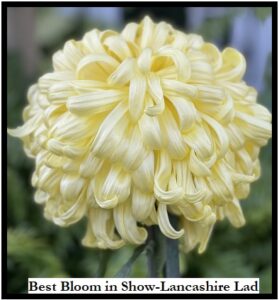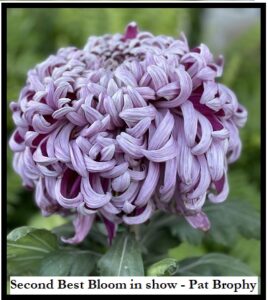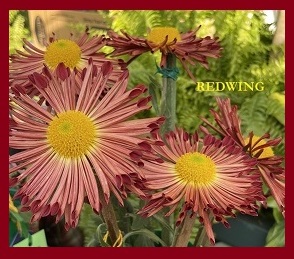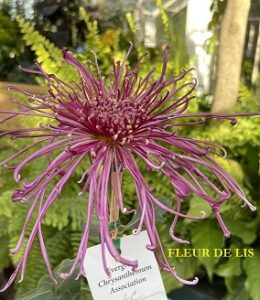EVERGREEN CHRYSANTHEMUM ASSOCIATION
Seattle, Washington
Nancy Halleen, Secretary
HAPPY VALENTINE’S DAY!
MEETING OF THE ECA – is scheduled for THURSDAY FEBRUARY 9, 2012 at
7:00 PM at the Seattle Police Athletic Association Office (SPAA) site at 11030 East Marginal Way South, Tukwila.
TELEPHONE COMMITTEE MEMBERS call your lists early in the week of February 6th as your calls do help to increase attendance.
ECA MEMBERSHIP
For those of you who haven’t yet renewed membership, the cost is $15 per member or $20 per couple. Only paid up members names can be included in the 2012 year book. So please make checks payable to ECA and mail to Christopher Brookes or pay in at the February meeting. If a member has any doubt whether they have paid or not please check with Chris. Thank you
Club Plant Sale The club has three membership only plant sales, one each at our February, March and April meetings. Additionally, a public plant sale is held in April. For this year it will be at Furney’s Nursery on Sat. Apr. 14th.
ECA growers are encouraged to bring started plants to the sales to help others who do not have the facilities to start new cuttings and/or to provide a cadre of plants for growers who wish to add new varieties, replace old, nonresponsive stock, etc. The price to the general membership is: $1.00 per plant. The price for plants to the public (April Sale) is: $2.00 per plant. In general the plants available at the Feb. and March sales will be the late varieties, classes 1 through 10. By March and through April, the earlier blooming varieties, i.e. Early English and many American varieties will show up.
New Members are promised 10 free plants with their membership. No more than 5 of the free plants should be selected at the Feb. meeting/sale and if the new member is not yet ready with facilities to care for the plants in Feb./March, he/she may wait till March or April to pick up their plants. This helps to assure the new grower success, avoid the early season pitfalls, and also provide access to a larger selection of plant varieties such as the early English and American varieties that are typically available in March and April.
Now is the time to develop your new growing plans. Then you can come to the plant sales ready to explore and buy. Don’s to 10 list for the exhibition varieties is included below. It may be helpful as you fill out your growing plans.
FALL SHOW
Thanks to Bob Ewing for tieing down the dates of the Fall Show. It will once again be at Furney’s on November 2, 3, and 4. Set up will be November 1st at 1 PM. Takedown will be on November 4th at 3 PM.
Other calendar dates will be set at the Board Meeting and shared with all members.
New Members are encouraged to contact Bob Ewing to be assigned a coach who will provide personalized growing instruction and advice. It is highly recommended that new members take advantage of this membership service. Don’t be shy give Bob a call!!!
Don’s Top 10
Below is a cherry picked list of exhibition mum varieties that are reliable, somewhat easy to grow and usually blooming at show time. I haven’t included garden varieties/American varieties or others, as there are multitudes of these available through Kings and other sources. There are doubtless many many good varieties that a few of you grow or have acquired. Most are early blooming and can be the subject of another report if someone so desires.
Don’s Top 10 (Cherry Picked) Exhibition mums for 2012
1. Connie Mayhew: (#2 Yellow that everyone should grow) One of the highest quality and most reliable
Cultivars in the club. A consistent winner and keeps well. The 2011 “Best Bloom Open Classes” was
that beautiful Connie from Ron Elliott.
2. Lundy and Yellow Lundy: (#2’s) Real winners and hard to beat in any category. They were also the
Cream of the crop of #2’s in the NCS National show of 2011. The White is brilliant and BIG and you’ll
love the yellow. These are Winners!
3. Apricot Harry Gee: (#1, AOC) Best Bloom in our Show 2011, It’s relatively easy to grow and comes
Into full bloom on time. Need I say more?
4. Len Hall: (#3 pink) this incurve is reliable and in my opinion the best incurve in our stable. It wins
Best Bloom novice, best incurve and best vase of three on a regular basis. It’s been declining with old
Age; but if you still have some good stock, start it and share with the rest of us.
5. Primrose Fairweather: (#3Y) this seems to be the best of the very good Fairweather family, it comes on
Well, finishes out the top and holds up for 2-3 weeks.
6. Seychelle: (#2P) A dark pink reflex that grows BIG, has almost perfect form, very smooth and likes
lots of fertilizer. Best Bloom in show twice.
7. Alexis and Apricot Alexis: (#5 Pink/AOC) Grows big and strong and epitomizes the form for #5’s.
8 Duke of Kent family: White, Cream, and Pink Dukes are the strongest and all can win Best in show.
New stock has revived these old time favorites.
9. Vienna Waltz: (#10 Purple) One of the best spiders to come along. It will hold its deep color well. It
Blooms reliably and on time and is a mainstay in the 3 bloom and 5 bloom vases. It’s a winner!
10.Lili Gallon: Purple with silver under petal (Cougar Colors) Changed from a #5 to a #2 in 2011
Sorry If I missed your favorite drs, 1/25/2012.
PLANT CULTURE – Continue to start plants for our public sale in April. Plants must be given protection for the first few months and carefully nurtured to establish strong root systems before potting or repotting. In February, take starts for the early blooming varieties. At this month’s meeting, the focus is growing plants, cultivar selection, materials and your reference books. Cultural recommendations are attached.
SUPPLIES – Supplies to be available at the February meeting.
· Plant Labels, White and Yellow 100 per pack.
· 2½” Plastic planting/starting cubes
· M&R Soilless Growing Media (Need enough orders to buy a pallet for a lower price). The cultural committee has decided to provide only M&R mix. It is a better product for mums than the mix used previously. This mix can be used for all pottings from the first 2 ½” pot to the 9 or 10” final pot. Contact Don Stark with Soilless orders.
Novice Handbooks will be available at the next meetings and the Public Plant Sale at a cost of $2.00 (payable to the Treasurer)
To receive monthly Newsletters by email only rather than U.S.mail, send an email to Nancy Halleen.
FEBRUARY TO DO LIST.. (New: 1-28-06 DRS)
Continue with cuttings:
Continue taking cuttings throughout Feb. and into March for some. A few early Feb. cuttings can be available for the March/April Plant sales (March Members sale at the March meeting and the public plant sale on Sat. April 14th). Most Feb. and March cuttings should be of the early English and American varieties. Late Decoratives) Classes 4, 5, 14 and 15) should be started primarily in Feb. Take cuttings for yourself and for the plant sale.
Most varieties in classes 1,2 and 3 should have been started by the end of January: however here are some varieties that can be successfully grown from Feb. cuttings. #1 & #2’s Lundy, Yellow Lundy, David Dando, Ralph Lambert, Yellow Ralph Lambert, Athabaska, Harry Gee, Jane Sharpe and Seychelle. #3’s Len Hall, Salmon, Primrose and yellow Fairweathers, Stockton and Heather James.
Cuttings started directly in the cutting bed media should not require fertilization before potting on. If you are starting in the cross bottom bands or 2” clay pots, fertilizer should be added after 3 to 4 weeks as these cutting generally require 5-6 weeks before potting on. Start fertilizing once a week beginning with the 4th week. Use an early Mum fertilizer, Peters 9-45-15 or Plant Marvel 12-45-10 (One Tsp/Gal once a week)
Potting on:
Most growers are using the soilless M&R potting mix sold by the club. In general no additives are required for the early pottings (2” and 4” pots); however some growers like to add some special ingredients. For instance Alfalfa meal or pellets is a good stimulant that can be added. Avoid adding Bone meal, as you will probably find fungi growing on the top of your pots due to too much potassium.
– Pot the mums directly from the cutting beds into 2” pots, or from the starter bands or pots into 3” or 4” pots.
– Use new pots, or wash previously used pots with a mild bleach solution (Clorox) to kill moss and eliminate the viruses. When bleach is used thoroughly rinse pots in fresh water to get the bleach out of the pot.
– Clay pots are recommended for the 2”, 3”, 4” and 6” potttings as the clay pots will dry out better than plastic after watering. This is especially important during the cool March and April days.
– Pot on from cutting beds when the roots are ½ to ¾ in. long (Typically 4 weeks) into 2 ½” or 3” pots.
– Pot on from cross bottom bands, or pots when roots are growing thickly out of the pots or bands (Typically 6 weeks). Do not compact the mix!
– Place the newly potted mums out of the light or under the bench for 2-3 days to stimulate root growth.
Care:
– Shelter mums in the greenhouse, cold frame, or other shelter (Kitchen table or south facing window)
– Temperature should be between 50 and 60 degrees.
– Glass overhead will help keep mums from getting leggy.
Care Continued:
– B-9 is a good growth retardant that tends to help plants from getting too leggy. It is available through the club. If you choose to use B-9 it should be applied at the time of potting on and again at or near pinch time. Caution: Do not use B-9 on plants that tend to naturally grow short: i.e. all the Fairweathers, all the Alexis, Port Stanley and others.
– Plants will remain in this first potting for 4-6 weeks until they have produced a noticeable root ring around the bottom of the pot. Don’t be afraid to knock the root ball out of the pot after several weeks and examine the roots.
– Fertilize with 9-45-15, or 12-45-10 beginning the 4th week
(1 Tsp/Gal once a week) These fertilizers are available through the
Club at the monthly meetings.
See you at the February 9th meeting!




